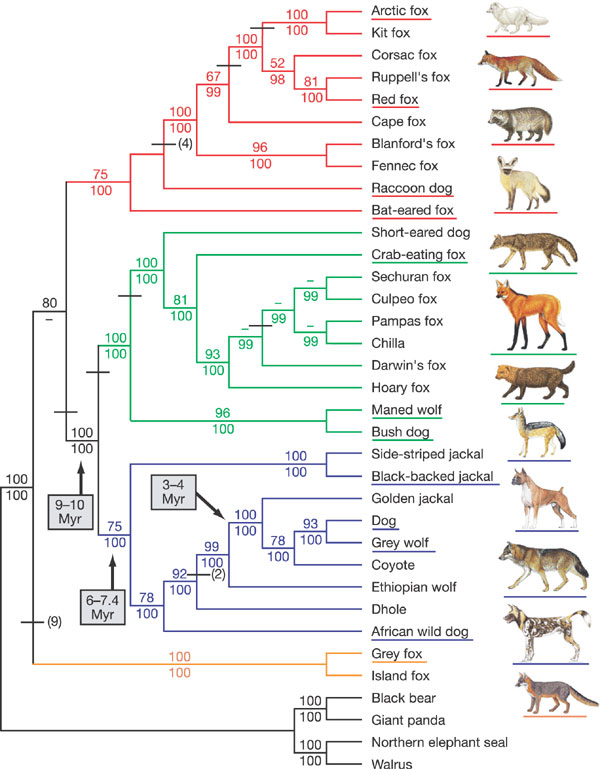The One and Only!
~~~~~~~~~~~~~~~~~~~~~~~~~~~~~~~~~~~~~~~~~~~~~~~~~~~~~~~
Classification
Chrysocyon brachyurus (Illiger, 1815).
Derived from Greek: Chrysocyon- GoldenDog brachyurus- Short Body
Common name: Maned wolf or the red wolf
Here's a complete classification of the maned wolf with the listed attributes as to why it fits into that category.
Do Kids Play Catch Over Farmer Greg's Shed?
Domain: Eukayota
Kingdom: Animalia
Phylum: Chordata
Class: Mammalia
Order: Carnivora
Family: Canidae
Genus: Chrysocyon
Species: Chrysocyon brachyurus
~~~Why Eukarya?~~~
The maned wolf is like other Eukaryotic organisms in that it is
multicellular, and the cells it possess each have advanced internal
structures such as a true nucleus and membrane bound organelles.
Each cell divides through mitosis for cell division and contains
multiple linear chromosomes (wikipedia.org/wiki/Eukaryote).
~~~Why Animalia?~~~
The maned wolf can be classified under the Animalia kingdom because
they are multicellular and heterotrophic in nature, meaning they
obtain nutrients by ingestion. Maned wolves lack cell walls and have
cells that are organized into tissues that have specific
functions. They are mobile at some stage in their life ,which is
also a characteristic of the Animalia kingdom (wikipedia.org/wiki/Animal).
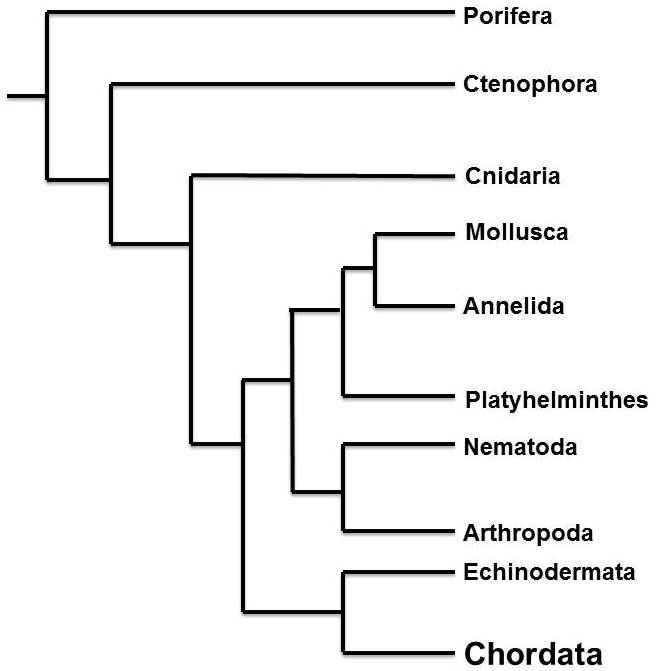 ~~~Why Chordata?~~~
~~~Why Chordata?~~~
Maned wolves are a part of the phylum Chordata for many reasons.
Firstly, they have bilateral symmetry which allows for a very
distinct head region and segmentation. Also, maned wolves have three
germ layers (triploblastic) and a complete digestive tract .
Chordates are also identified by having a notochord at one time
or another, as well as pharyngeal pouches, an endostyle (thyroid
gland), and a dorsal, tubular nerve chord. Because the maned wolf
matches this description, the organism can be classified under this phylum
(wikipedia.org/wiki/Chordate).
Eukarya Tree from Gerrish, Bio 203 2012
The phylogenetic tree located in the above image shows a broad resolution of where Chordates fit into the grand scheme of organisms in the Eukarya domain. This phylogenetic tree was constructed based on gene sequencing.
~~~Why Mammalia?~~~
Maned wolves are under the class Mammalia because they are
breathing vertebrate animals that possess hair, three middle ear
bones, and mammary glands. The mothers nurse their young with milk.
Mammals are endothermic, which means they are warm-blooded and
maintain a constant body temperature (wikipedia.org/wiki/Mammal).
~~~Why Carnivora?~~~
As the name states, members of the order Carnivora are
carnivores which means they primarily eat meat. Even though maned
wolves are omnivores and eat some plants and fruit, they also
consume large numbers of small vertebrates. Carnivores have
well-developed, prominent canine teeth and molars that have cutting
edges, strong, sharp claws, and binocular vision to help catch their
prey (wikipedia.org/wiki/Carnivora).
~~~Why Canidae?~~~
Canidae is the biological family of domestic dogs,
coyotes, jackals, foxes, wolves, and many other dog-like mammals.
Canids have fairly long legs and limber bodies, and are adapted for
chasing prey. Canids are digitigrade, meaning that they walk on
their toes. They possess bushy tails, non-retractile claws, and a
declaw, or thumb, on the front feet. Maned wolves most
certainly fall into this family; however, they are unlike most candids because they live solitary lives; whereas almost all canids
are social animals and live together in groups (wikipedia.org/wiki/Canidae).
~~~Why Chrysocyon?~~~
Even though maned wolves are in the Canidae family, which
contains
dogs, wolves, and foxes, the maned wolf is the only species
in the genus Chrysocyon. The maned wolf is not closely related to
any other living canid. It is not considered a fox, wolf, coyote, domestic dog,
or jackal, but instead a distinct canid genus and species
called Chrysocyon brachyurus (wikipedia.org/wiki/Maned_wolf).
Maned wolves are not considered a "true wolf," even though they are called wolves. They are the only large
dog-like animal that does not form packs to bring down their prey. Maned wolves generally live in territories with just one mate of the
opposite sex, which never hunt together and are rarely seen
together. Added to that, they
also eat a lot of fruit (graywolfconservation.com) (Go to
Nutrition).
Although they look like foxes and have the nickname “red fox on
stilts” some may think the maned wolf is closely related to the
foxes; however, they are not, for maned wolves do not have the elliptical
pupils that characterize foxes (wikipedia.org/wiki/Maned_wolf).
~~~~~~~~~~~~~~~~~~~~~~~~~~~~~~~~~~~~~~~~~~~~~~~~~~~~~~~~~
PHYLOGENY
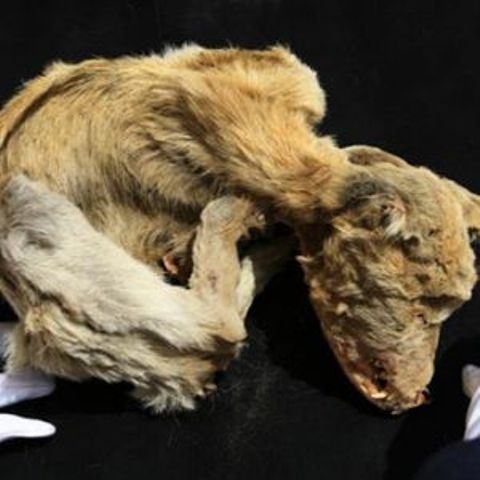 Being one of the most distinctive
animals in the Canidae family and in the world, the maned
wolf has an evolutionary history dating back six million
years to a time when many large canids became extinct in South
America. Since fossils of the maned wolf have been found in
Brazil from the Holocene and late Pleistocene era,
it has been concluded that of all the great sized South
American canids, the maned wolf was the only survivor of the late Pleistocene extinction (Rodden,
et al. 2008, wikipedia.org/wiki/Maned_wolf).
Being one of the most distinctive
animals in the Canidae family and in the world, the maned
wolf has an evolutionary history dating back six million
years to a time when many large canids became extinct in South
America. Since fossils of the maned wolf have been found in
Brazil from the Holocene and late Pleistocene era,
it has been concluded that of all the great sized South
American canids, the maned wolf was the only survivor of the late Pleistocene extinction (Rodden,
et al. 2008, wikipedia.org/wiki/Maned_wolf).
To the right is a picture of a dog mummy.
Image courtesy to
Scottie Westfall
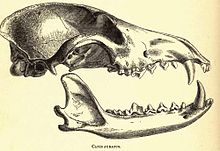 Many zoologists back in the nineteenth century
thought that maned
wolves were the most related to true wolves in Eurasia and North
America. It’s actually not (retrieverman.net). This species is most
closely related to the wild dogs and other South American Canidae,
such as the wolf-like foxes, the crab-eating fox, the short-eared
dog, and the bush dog. The closest living relative is the bush
dog which looks nothing similar to the maned wolf. Believe it or
not, the bush dog has undersized legs and has chocolate-colored
fur (wikipedia.org/wiki/Maned_wolf, retrieverman.net).
Many zoologists back in the nineteenth century
thought that maned
wolves were the most related to true wolves in Eurasia and North
America. It’s actually not (retrieverman.net). This species is most
closely related to the wild dogs and other South American Canidae,
such as the wolf-like foxes, the crab-eating fox, the short-eared
dog, and the bush dog. The closest living relative is the bush
dog which looks nothing similar to the maned wolf. Believe it or
not, the bush dog has undersized legs and has chocolate-colored
fur (wikipedia.org/wiki/Maned_wolf, retrieverman.net).
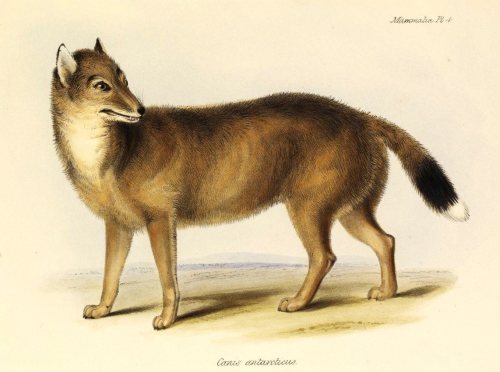 Although now extinct, the maned wolf’s closest relative was the
warrah, also known as the Falkland islands wolf
(picture at right) (retrieverman.net). A study published in 2009 claims that according
to DNA evidence, out of all canids studied the Falkland islands wolf was the most
closely related species to the maned wolf, and about 6 million years
ago the two organisms had a common ancestor(wikipedia.org/wiki/Maned_wolf).
Because both this organism and the maned wolf were bigger
than the South American foxes, they were called “wolves”
(retrieverman.net).
Although now extinct, the maned wolf’s closest relative was the
warrah, also known as the Falkland islands wolf
(picture at right) (retrieverman.net). A study published in 2009 claims that according
to DNA evidence, out of all canids studied the Falkland islands wolf was the most
closely related species to the maned wolf, and about 6 million years
ago the two organisms had a common ancestor(wikipedia.org/wiki/Maned_wolf).
Because both this organism and the maned wolf were bigger
than the South American foxes, they were called “wolves”
(retrieverman.net).

The image above shows the phylogenetic relationship between the maned wolf and its closest relatives. This tree was based on gene sequencing (COIImtDNA, CytB, and 4 nuclear loci)
I adapted this picture from the Evolutionary history of the Falklands wolf, 2009. The image above shows the phylogenetic relationship between maned wolves and domestic dog breeds based on gene sequencing (draft genome sequencing). Image credit to Scottie Westfall.
To find out where maned wolves live, go to
Habitat and Geography
Back to
HOME

